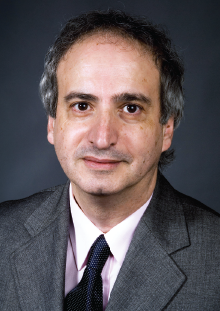ECT Said to Be Valid Alternative For Elderly Patients With Depression
Abstract
Age should be no barrier to receiving electroconvulsive therapy when indicated, clinical trials reveal.
“We don’t know exactly how electroconvulsive therapy works, but we do know a lot about what it does,” said Georgios Petrides, M.D., of the Zucker Hillside Hospital in Glen Oaks, N.Y., and an associate professor of psychiatry at Hofstra Northwell School of Medicine.

Exactly how ECT works still awaits revelation, according to Georgios Petrides, M.D.
“When I prescribe olanzapine to my patients, they never ask me, ‘How does this work?’ ” said Petrides at the annual meeting of the American Association for Geriatric Psychiatry in Washington, D.C., in March.
“Part of the problem lies in inconclusive basic research on ECT combined with our limited knowledge of the underlying biology of mental illnesses,” he pointed out during a session on the use of ECT for older patients. ECT’s effects are also not very specific. It works across the spectrum of mental illnesses, including depression and mania, psychosis, Parkinson’s disease, and catatonia. It also appears to be more efficacious in the most serious cases, rather than milder ones.
At least a dozen theories have been proposed as mechanisms of action for ECT but few, if any, have found much acceptance. Hypotheses began in the psychoanalytic era when it was suggested that ECT worked because of fear: the patient sought to avoid punishment, or was masochistic, or regressed under treatment to a pre-oedipal stage.
Others suggested that ECT caused a good kind of brain damage, a mysterious sort of psychosurgery. Amnesic theories argued that treatment made patients forget simply why they were depressed.
Neurotransmitter theories have suggested that ECT may increase dopamine release, decrease norepinephrine and serotonin, or cause changes in GABA or NMDA receptor activity.
Dukakis to Speak in Atlanta
How ECT gave former Mass. First Lady Kitty Dukakis a second chance at life will be described by her in a special Annual Meeting session, “Re-Examining ECT: From Patient Perspectives on Stigma to Benefit for Veteran Mental Health.” It will be held Monday, May 16, from 9 a.m. to noon in Room B407, Level 4, Georgia World Congress Center.
More recently, researchers have put forth network theories, suggesting that ECT affects brain connectivity, while others have proposed that specific brain areas (especially the subgenual cingulate region) are affected by depression and by ECT treatment.
Perhaps no single theory will explain ECT or what it can treat.
“Depression is not a monofactorial illness,” said Petrides. “And ECT, once deciphered, may be the royal road to the underlying biology of depression and to our understanding of treatments.”
Until that day comes, ECT is still valuable for geriatric patients, said Adriana Hermida, M.D., an assistant professor of psychiatry and behavioral sciences at Emory University.
Pharmacotherapy is the first line of treatment for behavioral and psychiatric symptoms in dementia in elderly patients despite a lack of evidence, said Hermida. “However, clinicians should consider other treatments if the patient is resistant to medications.”
Her review of the literature found a number of studies, often with small numbers of subjects, indicating that ECT can be used successfully in this population, she said. Her own research at Emory suggested that ECT was helpful in several ways: reducing agitation and the use of psychotropic agents and improving global functioning.
“ECT may be a treatment modality to consider for agitation and aggression in dementia especially when patients have been refractory to environmental modifications, behavioral interventions, and pharmacotherapy,” she said.
Some patients did have transient confusion, while others had cognitive problems that largely resolved six months after the initial treatment, she said.
Certain concessions to age should be made, however. “Consider using right unilateral electrode placement with ultrabrief pulse width,” she said. “Start with twice a week treatments rather than three and monitor the patient daily.”
A third speaker, Charles Kellner, M.D., a professor of psychiatry at the Icahn School of Medicine at Mt. Sinai in New York, also recommends use of ultrabrief pulses, less than 0.5 milliseconds.
ECT is effective, said Kellner, but relapse rates are higher than they were 20 years ago, possibly because of less powerful forms of ECT.
Safety issues, defined as physical injury or death, are minimal, he said. Tolerability is better with modern techniques but could still be improved.
“There is less retrograde amnesia than in the past, with very recent memories the most vulnerable,” he said. “Usually memory function returns to normal within a week. Some cognitive abnormalities can be distressing to patients, but they are usually transient and reversible.”
Kellner and colleagues have completed a multicenter study on ECT. The first phase found that 62 percent of elderly patients in the PRIDE study achieved remission from depression. The second phase randomized remitters to receive venlafaxine and lithium or a combination of the two medications plus continuation ECT. Results have not yet been published, but the combined treatment appeared more effective in this cohort of elderly patients, said Kellner.
“This is a viable treatment technique for geriatric depression,” he said “It acts rapidly, reduces suicidality very quickly, and is generally well tolerated, and the patients did well cognitively.”
The results showed that the extra ECT proved significantly better in maintaining lower symptom levels versus the pharmacotherapy-only arm for up to six months.
“Practitioners should be liberal in prescribing additional ECT after the acute course—both tapering and maintenance—for selected patients to prevent syndromic relapse,” he said. “We need to give patients as much ECT as they need and not stick to a rigid number of treatments.” ■
An abstract of “The Role of Electroconvulsive and Neuromodulation Therapies in the Treatment of Geriatric Depression” can be accessed here.



